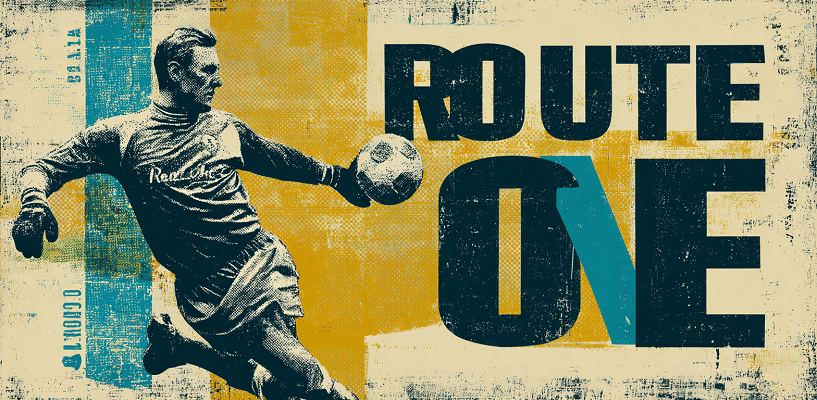Route One

Route One is a tactical approach that prioritizes quickly moving the ball from the defensive third into attacking areas with as few passes as possible, frequently using “long passes, crosses, and a target forward to win second balls.”
You’ll also hear it called “kick-and-rush,” “direct football” or “long-ball.” It’s not an official rule or formation — simply a tactical label used by coaches, commentators and fans.
Critics see it as “basic or unsophisticated” compared to possession-based tactics, but it can be very successful when used with the right players (e.g., tall forwards and quick wingers).
The Route One Debate: A Tactical Tool or a Rejection of Art? -
The Critics’ View (Unsophisticated) -
They see it as a rejection of the game’s artistic qualities — “the intricate passing, technical dribbling, and tactical buildup” that are often celebrated as “the beautiful game.” It’s viewed as a brute-force approach that bypasses the “brain” of the team (the midfield).
The Pragmatists’ View (Effective) -
As you said, with the right players, it can be “a devastatingly effective and perfectly legitimate” strategy. Why play 10 risky passes through a packed midfield if one “direct pass” can create a scoring opportunity? It’s a tool in the “tactical toolbox,” and dismissing it entirely is often a form of snobbery.
Crucial for the Right Players -
Deploying Route One without “a tall, physical” target man (like a Peter Crouch or a Christian Benteke in his prime) and without pacy players to run off him is a recipe for failure. It’s a specialized system built around specific strengths.
How Route One is Executed: A Typical Sequence -
- The Launch: A goalkeeper or defender receives the ball and looks to relieve pressure.
- The Long Ball: Instead of short passes, they play a “direct long pass” (often aerial, sometimes a long “ground/diagonal pass”) toward the opponent’s penalty area.
- The Target: The ball is aimed at a specific target player — usually “a tall, physically strong” striker (often called a target man) but sometimes a mobile forward.
- The Second Ball: The strategy doesn’t end with the target man. The idea is for him to win the initial “aerial duel” and either:
- Flick it on: Head the ball down or into the path of “a faster, secondary” striker/teammate.
- Hold it up: Bring the ball under control, shield it from defenders, and “allow supporting midfielders to join the attack.”
- The Finish: A second striker or “onrushing midfielder” collects the knockdown/layoff and attempts a shot or creates a chance.
When is “Route One” Typically Used? -
- By underdog or pragmatic teams facing technically “superior” opponents, to simplify play and reduce reliance on midfield possession.
- When a team is under heavy pressure (pinned in their own half) — “a long clearance or pass upfield” to a target can provide immediate relief.
- When a side lacks technical midfield control but has tall/physical attackers who can win “aerial duels” and lay the ball off.
- In poor playing conditions (strong wind, heavy rain, muddy pitch) when short passing is risky.
- Against opponents who are vulnerable in aerial duels or “weak at defending second balls.”
- As a “tactical counter” to an aggressive high press — bypassing the midfield with a direct ball.
Strengths of Route One -
- Simple: Easy to coach and execute, requiring less intricate technical play — though it does rely on accurate “long passes and forwards” who can win aerial duels or make runs behind the defense.
- Fast: Creates scoring chances in a single move by bypassing the opponent’s press and midfield structure, provided the “long ball and follow-up runs” are effective.
- Effective on the break: Excellent for counter-attacking when the opposition has committed players forward or is caught high.
- Useful when time/space is limited: A go-to option late in a game when chasing a goal, or “when a skilled opponent is denying midfield passing lanes.”
Weaknesses of Route One -
- Predictable: Opponents can counter by marking the target man, organizing zonal protection, or “dropping their line to cut the spaces behind.”
- Concedes possession frequently: Long balls are high-variance — many fail and immediately hand possession to the opponent.
- Reduced control over build-up: The team gives up tempo, ball retention, and probing via “shorter, creative” play.
- Depends on physicality and second-ball wins: Success often requires “winning the initial aerial duel and recovering the loose ball” — many of these are 50/50.
- Vulnerable to counters and positional gaps: If midfielders push forward or “the target is isolated,” the team can be exposed on the break.
- Can increase fouls/cautions and player fatigue: Frequent “aerial duels and physical battles” raise injury/foul risk and demand high physical output.
Famous Examples -
Wimbledon (the “Crazy Gang”) -
Wimbledon’s “Crazy Gang” (1980s–90s), famed for a Route One direct style, they used this to achieve massive success, including winning the “FA Cup” in 1988.
“Stoke City” under Tony Pulis — 2000s–2010s -
In the “Premier League,” they were known for their relentless long-throws and direct style, often using striker Peter Crouch as a target man.
Republic of Ireland (under Jack Charlton) -
Charlton famously coined and popularized the phrase “Put ’Em Under Pressure” for the Republic of Ireland — it summed up “a pragmatic, high-pressure, direct approach” (fast clearances/longer passes, quick transition and aggressive pressing) rather than elaborate possession football.
Bolton Wanderers under Sam Allardyce (early-mid 2000s) -
Allardyce’s Bolton was a physically intimidating Premier League side that used long diagonal balls to target powerful forwards like “Kevin Davies and Nicolas Anelka.” They were masters of the “second ball” and combined this direct approach with a lethal threat from set-pieces.
Sheffield United under Dave Bassett (late 1980s–1990s) -
Along with Wimbledon, Bassett’s Sheffield United were the archetypal “long-ball team” of their era. Their style was uncompromising and direct, successfully using it to achieve promotions and establish themselves in the top flight.
Lower-League and Non-League English Sides -
Route One is often a “pragmatic” necessity for teams with smaller budgets and less technical players. It’s an effective equalizer, perfect for “tight pitches, chaotic matches, and utilizing a physical advantage.”
Target forwards associated with the style -
Players like “Peter Crouch, Emile Heskey, Duncan Ferguson, and John Fashanu” — known for hold-up play, flick-ons, and winning aerial duels that Route One relies on.
That’s all friends.
Suggestions or corrections for this page can be submitted from the “contact us” page.
Ads Section

